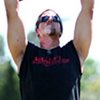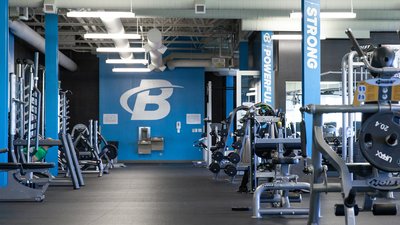Part 1 | Part 2
My journey into strength training began when I was 18. I weighed 160 pounds, had a small gut and a concave chest. I could not bench press 90 pounds to save my life and was in terrible shape. Just walking up several flights of stairs made me breathe heavily.
Although I had been a vegetarian for four years, my lifestyle was far from healthy and liked to party a lot. Nevertheless, the day that I could not bench press 90 pounds was a severe reality check for me. It was a clear message that I was out of shape and needed to make a change as soon as possible.
I decided to cut back on partying, work on better nutrition, hit the weights three times a week, and walk two miles every day (easy to do when you have an energetic golden retriever). Regarding nutrition, I increased my consumption of fruits and vegetables to five servings per day and made sure to drink ten glasses of water daily.
As the weeks and months went by, I literally felt my body change and my strength increase. After a few months, I bench pressed 220 pounds. A year later I hit 265 pounds and then I hit a roadblock. As I learned more about training and nutrition, I was able to make some more changes and was back on the road to progress. My bodyweight reached a solid 180 pounds. I actually had a chest now and my stomach flattened out. In addition, my energy and confidence went through the roof. I had caught the fitness bug and spent much of my free time studying different methods to improve my energy and strength.
The Benefits Of A Vegan Lifestyle
A few years later I learned the truth about the dairy and egg industries and decided to go vegan. Although it was difficult in the beginning, I soon discovered that there are a great number of delicious foods to feast on and I adapted quickly. Becoming a vegan had a profound effect on my training. Soon after going vegan, my bench press excelled past 315 pounds and I noticed that I recovered much faster. In addition, my body fat went down and I put on ten pounds of lean muscle in a few months.
Training
Today, several years later, I continue to follow a vegan diet and my training continues to get better every year. Over the last two years I decided to move away from standard weightlifting exercises such as bench pressing and curling and focus more on functional strength training.
Currently, I combine bodyweight exercises with kettlebell lifting. A kettlebell looks like a bowling ball with a handle and is great for both rapid and slow movements.
This combination of bodyweight exercises and kettlebell training is much more functional than standard bodybuilding exercises and in my opinion much more enjoyable. I do Kettlebell lifting three times a week and bodyweight exercises 2-3 times a week. Here is an example of my workout week:
Monday-Wednesday-Friday
I always start off each workout with a wrestler's back bridge (go to www.mattfurey.com for information on how to bridge) I hold the bridge for three to five minutes. This exercise really stretches my spine and energizes me for my workout. I have been doing it for two years and as a result I never suffer from lower back pain.
Next I move on to the kettlebell one-arm military presses. Since my left arm is slightly weaker than my right arm, I always start each set with my left arm when it is fresh. I warm up each arm with a 50-pound kettlebell and do three reps. From there, I move on to my working sets
Kettlebell Days:
- Kettlebell One-Legged Deadlift: 1 set of 5 reps, 2 sets of 5 reps 7 sets of 5 reps
Note: I take 60-second breaks between each set (after completing reps for both arms) Next, I do several sets of the kettlebell snatch to work my back, speed, and coordination. The snatch involves grabbing the kettlebell from the floor and in one swift motion taking the weight overhead. I recommend strongly Pavel Tsatsouline's "Russian Kettlebell Challenge" video for proper execution of all KB lifts. After doing a few warm up sets with a 60-pound KB, I move up to 90 pounds and do three sets of ten.
Tuesday-Thursday
Similar to my kettlebell workouts, I always start my bodyweight workouts with the wrestler's bridge. Again, I hold this position for 3-to-5 minutes. Next, I move on to full range handstand push-ups between two chairs. I use two sturdy dinning room table chairs and place them about a foot and a half apart and about two feet away from a wall.
From there I kick into a handstand on top of the chairs and place my feet firmly against the wall. I breathe in as I lower my body to the floor and hold my breath as I press back up to the starting position. Holding my breath keeps my body tight and strong during the pressing portion of the exercise. I do five sets of five.
After handstand push-ups, I do one-legged squats and ab wheel roll-outs from my feet. One-legged squats are an incredible exercise for functional leg strength as well as for increasing balance and focus.
Bodyweight Exercises:
- Ab Roller
- One-Leg Barbell Squat
Note: To start, hold one leg slightly in front of you and place your arms straight in front of you for balance. As you lower your body, bend down and turn slightly to the leg that you are holding out. Breathe in as you go down and breathe out as you come up.
Be sure to keep your arms in front of you during the entire range of motion and look straight ahead. These take a while to learn, so do not be frustrated if you cannot even manage one in the beginning. I do five sets of five one-legged squats.
For ab rolls, I use an ab roller that you can get at Bodybuilding.com for less than $10. If you are not familiar with this device, it looks like a small bicycle wheel with a handle on each side. To do full range ab rolls, start the exercise on your fee and roll the wheel as far out as you can. If this is too difficult, start off on your feet and gradually progress to a standing roll out. This is a fantastic exercise for lean, solid and functional abs. After that, I do some light stretching and call it a day. All of my workouts take less than 45 minutes and most are around 30 minutes.
Next, I will get into what I eat on a daily basis and when to eat what to maximize fat burning, muscle building, and workout performance.
Part 1 | Part 2


